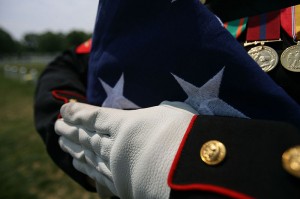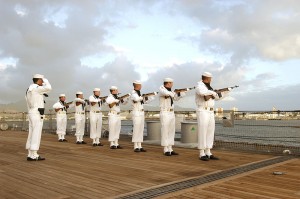
Credit: Wikipedia
Even for those who have never personally attended a military funeral, most Americans are familiar with the traditional customs that are practiced during the ceremony. The image of booming shots echoing in the calm of a grave site after a particularly action-packed battle scene are saturated in all forms of American media. As a country, it seems, we have an obsession with remembering all of our heroes, fictional or otherwise. And perhaps the most iconic way that our heroes are honored at a military funeral is by firing guns at the grave site. But where does this tradition come from and what does it mean? Although the symbolism may be lost on civilians who are so familiar with this iconic practice, the history behind this tradition is rooted in antiquity.
Perhaps the most iconic way that our heroes are honored at a military funeral is by firing guns at the grave site.
The practice of incorporating weaponry as a funeral custom for honoring heroes dates far before the invention of gunpowder and it has been a culturally universal practice that predates most forms of record keeping. It’s a metaphor, as Augustus Waters would say, where you keep the killing thing close, but “you don’t give it the power to kill.” And in many cultures, this has been the tradition among ancient tribes that would bring spears to funerals as well. In all of these cases, with spears brought to funerals with the pointed end facing the dirt, or in modern times as we fire shots off into the distance, the idea is that with the firing of the weapon, or the disarming of the spear, we are honoring a hero and a warrior by purposefully, temporarily disarming a weapon that may have been their downfall.
The practice of incorporating weaponry as a funeral custom for honoring heroes dates far before the invention of gunpowder.

Credit: Wikipedia
In August of 1875, the 21 gun salute was recognized by the British and American people as an international practice for military funerals. While it is a common misconception that the salute calls for 21 shots to be fired, in actuality, this was originally because there were 21 states in the union at the time the salute was officially recognized in America. Today, this salute is reserved for honoring the flag or for honoring political dignitaries both alive and dead.
The idea is that with the firing of the weapon, or the disarming of the spear, we are honoring a hero and a warrior by purposefully, temporarily disarming a weapon that may have been their downfall.
Although the practice that most people are familiar with today is that of the 21 gun salute, this practice is often mistaken for the much more common practice of firing three rifle volleys over the grave of the person being honored. That practice has its own different history. Firstly, the firing of volleys is a much more common practice used for honoring any veteran, as opposed to a more highly decorated war hero or dignitary. This would be the equivalent of slaughtering a goat for a standard Xhosa funeral feast, as opposed to slaughtering an ox and a lion. Historically, the firing of volleys would take place on a battlefield to indicate that the dead had been cleared from the field and were now taken care of.
Today, the volleys are used to honor veterans who die in active duty, honorably discharged veterans and military retirees in general. Being a veteran is for life, and when the time comes for planning a funeral for a veteran, it’s important to remember that most people who have served can become a part of this ancient tradition. Contacting your local V.A. to find out more about planning a military funeral is the perfect place to start.
Related SevenPonds’ Articles:
- Traditional U.S. Military Funeral Service
- Nationwide Events to Commemorate 9/11
- What is Ash Scattering? An Interview with Gary Trovinger

 The History Behind Firing Guns at Military Funerals
The History Behind Firing Guns at Military Funerals


 Flawed Kidney Function Test Discriminated Against Black Patients
Flawed Kidney Function Test Discriminated Against Black Patients

 Harmony Amidst Change: Japan’s Kezouin Fuchu-shi Cemetery
Harmony Amidst Change: Japan’s Kezouin Fuchu-shi Cemetery














